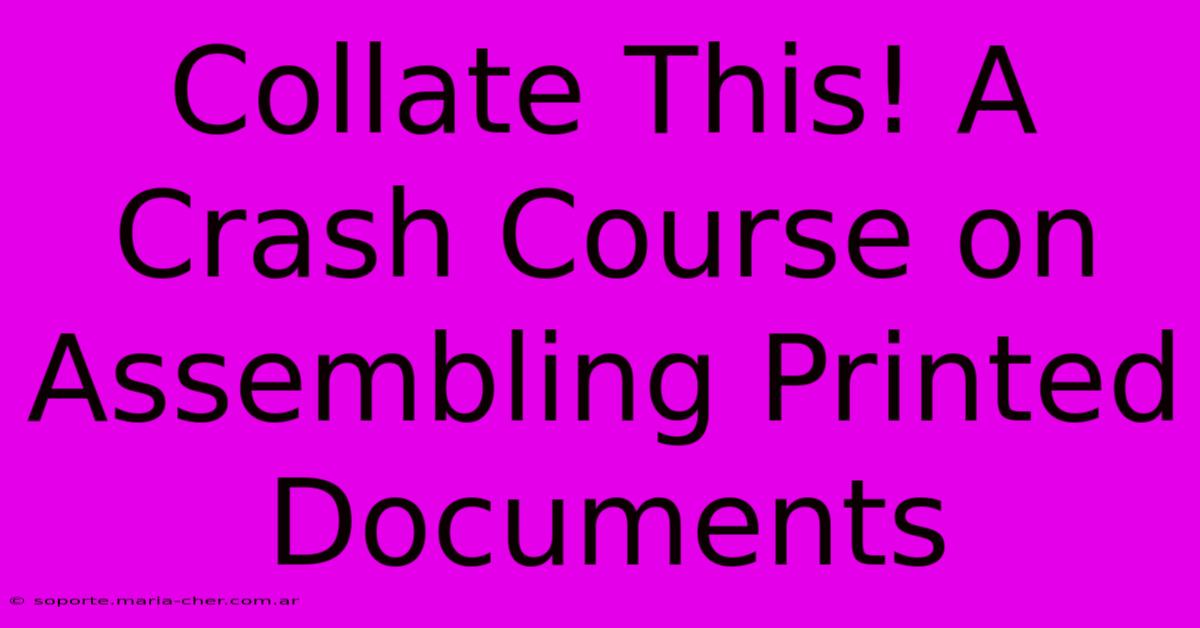Collate This! A Crash Course On Assembling Printed Documents

Table of Contents
Collate This! A Crash Course on Assembling Printed Documents
So, you've finished printing your important document – a multi-page report, a booklet, a presentation, or even a stack of personalized letters. But the job's not done yet! Before you can distribute or bind your finished product, you need to collate. This seemingly simple task can be surprisingly tricky, especially with large volumes or complex projects. This crash course will cover everything you need to know about collating printed documents efficiently and accurately.
Understanding Collation: More Than Just Stacking Paper
Collation simply means arranging printed pages in the correct order. It's about ensuring that pages 1, 2, 3, and so on follow sequentially to create a complete and readable document. This might seem obvious, but with multiple copies and page numbers, it can quickly become a headache without a systematic approach. Efficient collation is crucial for professional presentation and avoiding costly reprints.
Types of Collation
There are several types of collation, each appropriate for different situations:
-
Simple Collation: This involves arranging pages in order for a single document. It's the most straightforward type and often done manually, especially for smaller print jobs.
-
Multiple Set Collation: This refers to collating multiple sets of the same document. For example, if you need 20 copies of a 10-page report, you need 20 sets of pages 1-10.
-
Complex Collation: This involves documents with multiple sections or inserts, requiring careful attention to page order. Think brochures, manuals with different chapters, or projects with various inserts.
-
Signature Collation: This is used primarily for larger print projects like books or magazines. It involves assembling groups of pages (signatures) that are then folded and gathered together.
Mastering the Art of Manual Collation
For smaller projects, manual collation is a viable and cost-effective option. Here's how to do it effectively:
1. Preparation is Key:
- Check your print job: Before you even begin, ensure your document has printed correctly. Verify page numbers and check for any missing or duplicated pages.
- Organize your print output: Separate the pages into manageable stacks based on page number if necessary. This makes the process less overwhelming.
- Clear workspace: Ensure you have a clean, spacious work area. Clutter can lead to errors and frustration.
2. The Collation Process:
- Use a consistent method: Establish a rhythm – whether that's picking up pages one at a time or in small batches – to maintain accuracy.
- Check frequently: Regularly review your collated sets to identify and correct any errors early. It's far easier to fix a mistake early than later.
- Consider using a guide sheet: For multiple-copy projects, creating a guide sheet with page numbers can significantly improve speed and accuracy.
Beyond Manual: Utilizing Technology for Efficiency
For larger projects or when speed is critical, utilizing technology becomes essential:
- Professional Printing Services: Printing companies often offer professional collating services, ensuring accuracy and efficiency, particularly for complex projects. This saves you time and ensures a high-quality finished product.
- High-Volume Printers with Collating Capabilities: Some advanced printers include automated collating features, which can significantly speed up the process. However, it's important to note this feature often only applies to a limited number of sets.
Troubleshooting Common Collation Issues
Even the most experienced can encounter challenges. Here are some common problems and solutions:
- Missing Pages: Double-check your print output to confirm all pages were printed.
- Incorrect Page Order: Carefully review the collated documents and correct any discrepancies.
- Misaligned Pages: If your pages are misaligned, it might be an issue with your printer settings.
Beyond Collation: The Final Steps
Once you've successfully collated your documents, consider the next steps in your workflow:
- Binding: Depending on your project's requirements, you might need to bind your collated pages using methods like stapling, spiral binding, or perfect binding.
- Finishing Touches: This might include adding covers, trimming edges, or incorporating other finishing elements.
Mastering collation is an essential skill for anyone dealing with printed documents. By following these tips and adapting them to your specific needs, you can ensure your documents are always presented professionally and accurately. Remember that accuracy and consistency are paramount – a little extra care goes a long way!

Thank you for visiting our website wich cover about Collate This! A Crash Course On Assembling Printed Documents. We hope the information provided has been useful to you. Feel free to contact us if you have any questions or need further assistance. See you next time and dont miss to bookmark.
Featured Posts
-
The Pinecone Paradox How Times Fractal Nature Influences Our Perception
Feb 07, 2025
-
The Dark Side Of Advertising Revealing The Secrets Of Deceptive Fake Ads
Feb 07, 2025
-
Unleash Limitless Creativity The Futura Now Trial Your Essential Tool For Typography Mastery
Feb 07, 2025
-
From Amateur To Pro Transform Your Photography With The Best 50mm F 1 8 E Mount Lens
Feb 07, 2025
-
The Ultimate Guide To Improving Decision Making Leveraging Affect Heuristics
Feb 07, 2025
